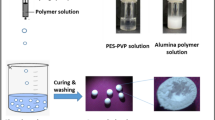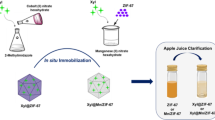Abstract
Mesoporous silica particles were prepared for efficient immobilization of the β-glucuronidase (GUS) through a biomimetic mineralization process, in which the solution containing lysozyme and GUS were added into the prehydrolyzed tetraethoxysilane (TEOS) solution. The silica particles were formed in a way of biomineralization under the catalysis of lysozyme and GUS was immobilized into the silica particles simultaneously during the precipitation process. The average diameter of the silica particles is about 200 nm with a pore size of about 4 nm. All the enzyme molecules are tightly entrapped inside the biosilica nanoparticles without any leaching even under a high ionic strength condition. The immobilized GUS exhibits significantly higher thermal and pH stability as well as the storage and recycling stability compared with GUS in free form. No loss in the enzyme activity of the immobilized GUS was found after 30-day’s storage, and the initial activity could be well retained after 12 repeated cycles.
Similar content being viewed by others
References
Lee C H, Lin T S, Mou C Y. Mesoporous materials for encapsulating enzymes. Nano Today, 2009, 4(2): 165–179
Schmid A, Dordick J S, Hauer B, Kiener A, Wubbolts M, Witholt B. Industrial biocatalysis today and tomorrow. Nature, 2001, 409(6817): 258–268
Bornscheuer U T. Immobilizing enzymes: How to create more suitable biocatalysts. Angewandte Chemie International Edition, 2003, 42(29): 3336–3337
Eggers D K, Valentine J S. Molecular confinement influences protein structure and enhances thermal protein stability. Protein Science, 2008, 10(2): 250–261
Kim J, Grate JW, Wang P. Nanostructures for enzyme stabilization. Chemical Engineering Science, 2006, 61(3): 1017–1026
Pioselli B, Bettati S, Mozzarelli A. Confinement and crowding effects on tryptophan synthase α 2 β 2 complex. FEBS Letters, 2005, 579(10): 2197–2202
Reátegui E, Aksan A. Structural changes in confined lysozyme. Journal of biomechanical engineering, 2009, 131(7): 074520.1–074520.4
Zhou H X. Protein folding in confined and crowded environments. Archives of Biochemistry and Biophysics, 2008, 469(1): 76–82
Zhou H X. Protein folding and binding in confined spaces and in crowded solutions. Journal of Molecular Recognition, 2004, 17(5): 368–375
Zhou H X, Dill K A. Stabilization of proteins in confined spaces. Biochemistry, 2001, 40(38): 11289–11293
Avnir D, Coradin T, Lev O, Livage J. Recent bio-applications of solgel materials. Journal of Materials Chemistry, 2006, 16(11): 1013–1030
Kim Y H, Lee I, Choi S H, Lee O K, Shim J, Lee J, Kim J, Lee E Y. Enhanced stability and reusability of marine epoxide hydrolase using ship-in-a-bottle approach with magnetically-separable mesoporous silica. Journal of Molecular Catalysis. B, Enzymatic, 2013, 89: 48–51
Pastor I, Ferrer M L, Lillo M P, Gómez J, Mateo C R. Structure and dynamics of lysozyme encapsulated in a silica sol-gel matrix. Journal of Physical Chemistry B, 2007, 111(39): 11603–11610
Khanna S, Goyal A, Moholkar V S. Mechanistic investigation of ultrasonic enhancement of glycerol bioconversion by immobilized clostridium pasteurianum on silica support. Biotechnology and Bioengineering, 2013, 110(6): 1637–1645
Luckarift H R, Spain J C, Naik R R, Stone M O. Enzyme immobilization in a biomimetic silica support. Nature Biotechnology, 2004, 22(2): 211–213
Pouget E, Dujardin E, Cavalier A, Moreac A, Valéry C, Marchi-Artzner V, Weiss T, Renault A, Paternostre M, Artzner F. Hierarchical architectures by synergy between dynamical template self-assembly and biomineralization. Nature Materials, 2007, 6(6): 434–439
Rusu V M, Ng C H, Wilke M, Tiersch B, Fratzl P, Peter M G. Sizecontrolled hydroxyapatite nanoparticles as self-organized organic-inorganic composite materials. Biomaterials, 2005, 26(26): 5414–5426
Zhang Y F, Wu H, Li L, Li J, Jiang Z Y, Jiang Y J, Chen Y. Enzymatic conversion of baicalin into baicalein by β-glucuronidase encapsulated in biomimetic core-shell structured hybrid capsules. Journal of Molecular Catalysis. B, Enzymatic, 2009, 57(1–4): 130–135
Naik R R, Tomczak M M, Luckarift H R, Spain J C, Stone M O. Entrapment of enzymes and nanoparticles using biomimetically synthesized silica. Chemical Communications, 2004, (15): 1684–1685
Miller S A, Hong E D, Wright D. Rapid and efficient enzyme encapsulation in a dendrimer silica nanocomposite. Macromolecular Bioscience, 2006, 6(10): 839–845
Zhang Y F, Wu H, Li J, Li L, Jiang Y J, Jiang Z Y, Jiang Z. Protamine-templated biomimetic hybrid capsules: Efficient and stable carrier for enzyme encapsulation. Chemistry of Materials, 2008, 20(3): 1041–1048
Naik R R, Brott L L, Clarson S J, Stone M O. Silica-precipitating peptides isolated from a combinatorial phage display peptide library. Journal of Nanoscience and Nanotechnology, 2002, 2(1): 95–100
Kroger N, Deutzmann R, Sumper M. Silica-precipitating peptides from diatoms. Journal of Biological Chemistry, 2001, 276(28): 26066–26070
Luckarift H R, Dickerson M B, Sandhage K H, Spain J C. Rapid, room-temperature synthesis of antibacterial bionanocomposites of lysozyme with amorphous silica or titania. Small, 2006, 2(5): 640–643
Coradin T, Coupé A, Livage J. Interactions of bovine serum albumin and lysozyme with sodium silicate solutions. Colloids and Surfaces. B, Biointerfaces, 2003, 29(2–3): 189–196
Shiomi T, Tsunoda T, Kawai A, Mizukami F, Sakaguchi K. Synthesis of a cagelike hollow aluminosilicate with vermiculate micro-through-holes and its application to ship-in-bottle encapsulation of protein. Small, 2009, 5(1): 67–71
Ramanathan M, Luckarift H R, Sarsenova A, Wild J R, Ramanculov E K, Olsen E V, Simonian A L. Lysozyme-mediated formation of protein-silica nano-composites for biosensing applications. Colloids and Surfaces. B, Biointerfaces, 2009, 73(1): 58–64
Garakani T M, Wang H H, Krappitz T, Liebeck B M, Vanrijn P, Boker A. Lysozyme-silica hybrid materials: From nanoparticles to capsules and double emulsion mineral capsules. Chemical Communications, 2012, 48(82): 10210–10212
Ivnitski D, Artyushkova K, Rincon R A, Atanassov P, Luckarift H R, Johnson G R. Entrapment of enzymes and carbon nanotubes in biologically synthesized silica: Glucose oxidase-catalyzed direct electron transfer. Small, 2008, 4(3): 357–364
Luckarift H R, Balasubramanian S, Paliwal S, Johnson G R, Simonian A L. Enzyme-encapsulated silica monolayers for rapid functionalization of a gold surface. Colloids and Surfaces. B, Biointerfaces, 2007, 58(1): 28–33
Cao X D, Yu J C, Zhang Z Q, Liu S Q. Bioactivity of horseradish peroxidase entrapped in silica nanospheres. Biosensors & Bioelectronics, 2012, 35(1): 101–107
Cushnie T, Lamb A J. Antimicrobial activity of flavonoids. International Journal of Antimicrobial Agents, 2005, 26(5): 343–356
Ma Z, Otsuyama K i, Liu S, Abroun S, Ishikawa H, Tsuyama N, Obata M, Li F J, Zheng X, Maki Y. Baicalein, a component of scutellaria radix from Huang-Lian-Jie-Du-Tang (HLJDT), leads to suppression of proliferation and induction of apoptosis in human myeloma cells. Blood, 2005, 105(8): 3312–3318
Zhu J T, Choi R C, Chu G K, Cheung A W, Gao Q T, Li J, Jiang Z Y, Dong T T, Tsim KW. Flavonoids possess neuroprotective effects on cultured pheochromocytoma PC12 cells: A comparison of different flavonoids in activating estrogenic effect and in preventing β-amyloid-induced cell death. Journal of Agricultural and Food Chemistry, 2007, 55(6): 2438–2445
Matte C R, Nunes M R, Benvenutti E V, Schöffer J N, AyubM A Z, Hertz P F. Schöffer J d N, Ayub M A Z, Hertz P F. Characterization of cyclodextrin glycosyltransferase immobilized on silica microspheres via aminopropyltrimethoxysilane as a “spacer arm”. Journal of Molecular Catalysis. B, Enzymatic, 2012, 78: 51–56
Martín M T, Plou F J, Alcalde M, Ballesteros A. Immobilization on Eupergit C of cyclodextrin glucosyltransferase (CGTase) and properties of the immobilized biocatalyst. Journal of Molecular Catalysis. B, Enzymatic, 2003, 21(4–6): 299–308
Miller S A, Hong E D, Wright D. Rapid and efficient enzyme encapsulation in a dendrimer silica nanocomposite. Macromolecular Bioscience, 2006, 6(10): 839–845
Author information
Authors and Affiliations
Corresponding author
Rights and permissions
About this article
Cite this article
Song, X., Jiang, Z., Li, L. et al. Immobilization of β-glucuronidase in lysozyme-induced biosilica particles to improve its stability. Front. Chem. Sci. Eng. 8, 353–361 (2014). https://doi.org/10.1007/s11705-014-1421-2
Received:
Accepted:
Published:
Issue Date:
DOI: https://doi.org/10.1007/s11705-014-1421-2




